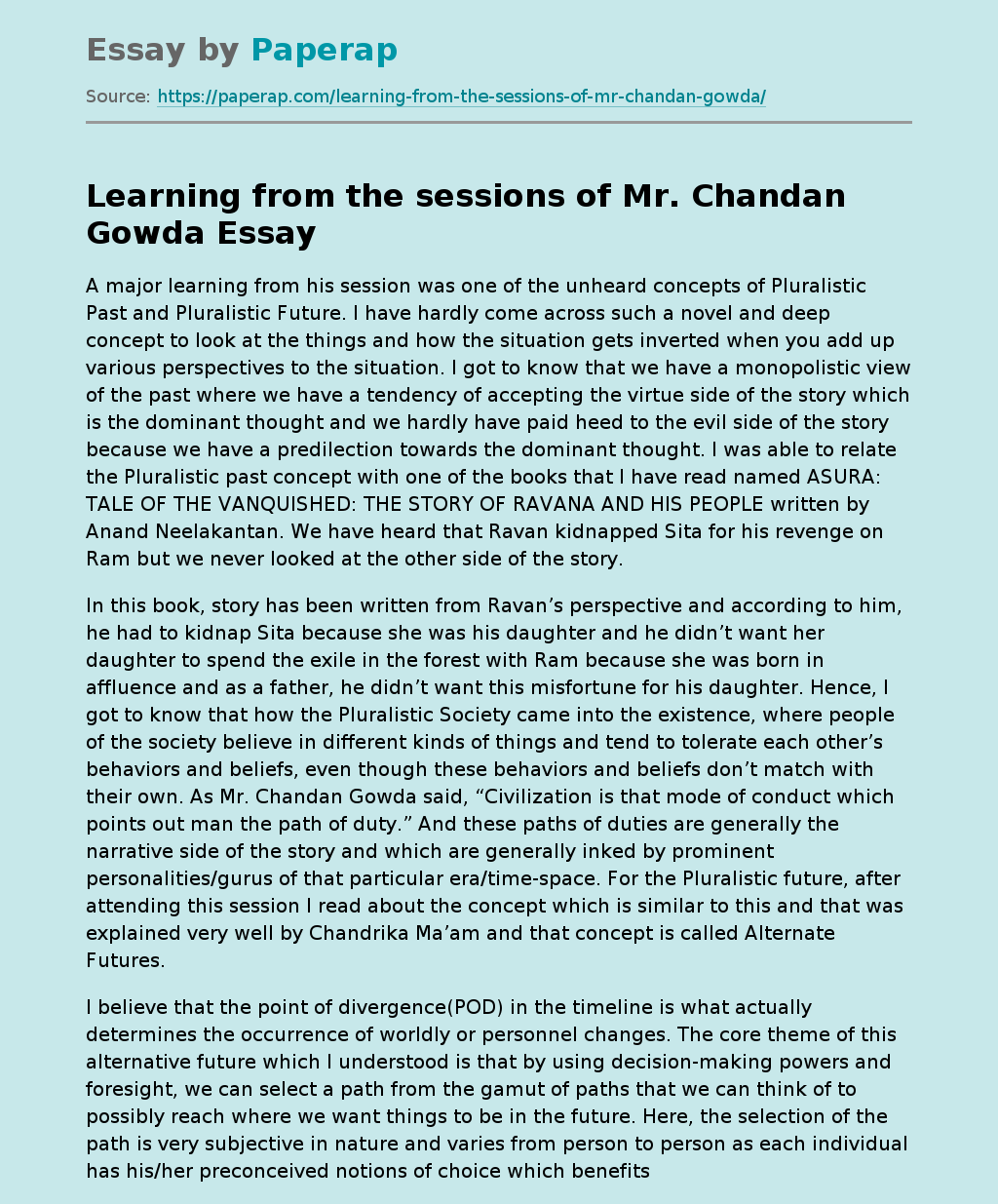Learning from the sessions of Mr. Chandan Gowda
A major learning from his session was one of the unheard concepts of Pluralistic Past and Pluralistic Future. I have hardly come across such a novel and deep concept to look at the things and how the situation gets inverted when you add up various perspectives to the situation. I got to know that we have a monopolistic view of the past where we have a tendency of accepting the virtue side of the story which is the dominant thought and we hardly have paid heed to the evil side of the story because we have a predilection towards the dominant thought.
I was able to relate the Pluralistic past concept with one of the books that I have read named ASURA: TALE OF THE VANQUISHED: THE STORY OF RAVANA AND HIS PEOPLE written by Anand Neelakantan. We have heard that Ravan kidnapped Sita for his revenge on Ram but we never looked at the other side of the story.
In this book, story has been written from Ravan’s perspective and according to him, he had to kidnap Sita because she was his daughter and he didn’t want her daughter to spend the exile in the forest with Ram because she was born in affluence and as a father, he didn’t want this misfortune for his daughter.
Hence, I got to know that how the Pluralistic Society came into the existence, where people of the society believe in different kinds of things and tend to tolerate each other’s behaviors and beliefs, even though these behaviors and beliefs don’t match with their own.
As Mr. Chandan Gowda said, “Civilization is that mode of conduct which points out man the path of duty.” And these paths of duties are generally the narrative side of the story and which are generally inked by prominent personalities/gurus of that particular era/time-space. For the Pluralistic future, after attending this session I read about the concept which is similar to this and that was explained very well by Chandrika Ma’am and that concept is called Alternate Futures.
I believe that the point of divergence(POD) in the timeline is what actually determines the occurrence of worldly or personnel changes. The core theme of this alternative future which I understood is that by using decision-making powers and foresight, we can select a path from the gamut of paths that we can think of to possibly reach where we want things to be in the future. Here, the selection of the path is very subjective in nature and varies from person to person as each individual has his/her preconceived notions of choice which benefits them. Even, to look at the possible futures is very subjective in nature. Also, I was able to make some insights regarding BREXIT (Britain’s exit from the European Union) using this concept. Citing the viewpoint here might be biased because the alternate future of Britain is the way I see BREXIT as per my given dimension of reading and knowledge but to summarize, now I am able to look at the perspective in a very different and sometimes in a very eccentric manner after having attended these sessions.
Learning from the sessions of Mrs. Gurmeet Rai
Heritage Protection, Conservation, and Management: Reconciling Transformation and Recovery- This was the basic theme of the sessions. I got to understand that what we can do to preserve our heritage and I would like to present my understating of this concept because what I believe is that the heritage of past civilizations does not have a clear future, but it gives a chance to each of us to make sure that this heritage of past remains secure in the future. When we are confronted with the latest news about cultural heritage destruction or an update of a trafficking case or an auction that is questionable, we find it easy to feel helpless and to ponder that this work/task is insurmountable if the aim is to preserve and protect cultural heritage both for posterity and the present. However, armed with information, each one of us individually can become a very strong potential advocate in promoting an environment that is safer for both cultural heritage as well as for cultural property.
The kind of work that is being done by Mrs. Gurmeet Rai is very similar to this in the area of Amritsar, Sri Nagar where she is working relentlessly to protect the heritage sites or how they can preserve these sites for future generations. One route to perform heritage protection is to find of whether the site is protected(legally) or unprotected as discussed in the session. After deciding this chose the route which has the best practices during visiting museums and heritage sites, endeavoring to preserve the museums and heritage sites in the very promising/best condition possible for the upcoming future generation.
Another route according to me is to reprobate to take part in any activities that cause illicit trafficking, including questionable art auctions and online resale sites. Yet another route can be to become a powerful advocate, interfering with both non-governmental and governmental agencies that work as an agent for culture. Here the aim should be to reinforce and strengthen the coexistence of natural and cultural identities as discussed by ma’am in the session. Sometimes we also need to focus on Intangible heritage (like Syncretic Traditions discussed in the session) as Mrs. Gurmeet Rai said, “Heritage is much more than preserving, displaying, excavating, or restoring a collection of old things. It includes tangible and intangible elements of ideas and memories.
Learning from the sessions of Mr. Chandan Gowda. (2021, Dec 13). Retrieved from https://paperap.com/learning-from-the-sessions-of-mr-chandan-gowda/

